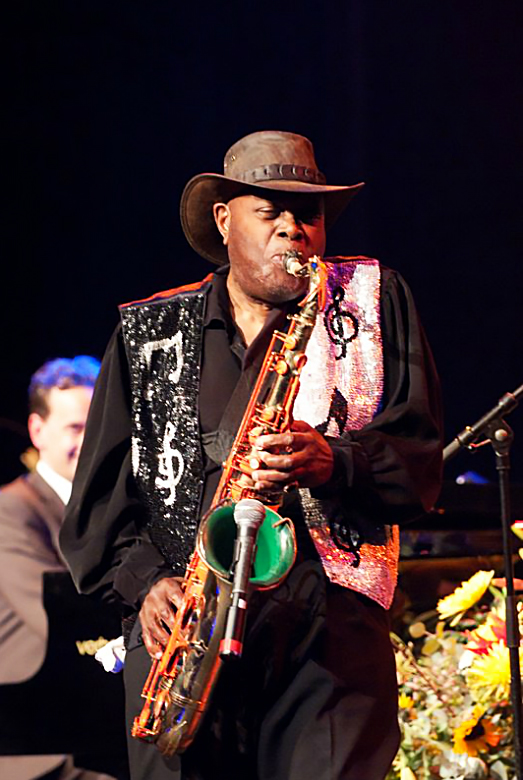
Photo: courtesy of Big Jay McNeely
Big Jay McNeely made some of the biggest waves on the 1940s R&B scene with his screaming tenor sax
As one of the titans who made tenor sax the solo instrument of choice during rock’s primordial era in the late 1940s, Big Jay McNeely could peel the paper right off the walls with his sheets of squealing, honking horn riffs. “The king of the honkers” has been wailing hard for over seven decades, and he’s still going strong.
Born in Watts, California, on April 29, 1927, McNeely formed his own band with jazz legends Sonny Criss (alto sax) and Hampton Hawes (piano) while still in high school. He joined the musicians union in 1944, which at that time in Los Angeles was segregated. (His membership in the black Local 767 transferred to Local 47 when the two unions amalgamated in 1953, and he now holds a Life Membership card.) In late 1948, when he was asked to record for Savoy Records, he abandoned jazz for something more raucous and struck paydirt when his second release, a honked-up instrumental called “Deacon’s Hop,” went to No. 1 on the national R&B charts in February 1949.
For the next several years, Big Jay, according to the New Rolling Stone Encyclopedia of Rock & Roll, “was famed for his playing-on-his-back acrobatics and his raw, hard-swinging playing.” During his act he’d leave the stage, walk across the top of the bar, and sometimes walk out the door of the club, often with a line of people following him. Once, in San Diego, during one such “walk,” he was arrested on the street for disturbing the peace; inside the club, his band kept playing until someone could rush down to the police station, post Big Jay’s bail, and bring him back to finish his song.
In the 1950s Big Jay added vocal groups to his act, beginning with Four Dots & Dash, which included, at one time or another, 16-year-old Jesse Belvin, Marvin Phillips (later of Marvin & Johnny fame), Tony Allen and Mel Williams. In fact, Belvin made his first recordings with Big Jay, including “All That Wine Is Gone.” Big Jay also worked extensively with The Hollywood Flames, The Penguins and The Medallions up and down the West Coast. In 1955-56 he shared the stage with the Clovers, the Harptones (at the Apollo Theater), Bill Haley and His Comets, the Moonglows, Little Richard, and others.
In 1959 Big Jay enjoyed his biggest hit, a blues ballad called “There Is Something on Your Mind,” featuring Haywood “Little Sonny” Warner on vocals. The record stayed on the R&B charts for six months and reached as high as 44 pop. The song was later a hit for Bobby Marchan. Other artists who have recorded Big Jay’s song include B.B. King, Etta James, Freddy Fender, The Hollywood Flames, Gene Vincent, Albert King and Professor Longhair.
Big Jay had been retired from full-time music for 20 years, but in 1983 he returned to performing and hasn’t looked back. He is still tearing it up at venues around the world and knows how to delight and entertain an audience of any size, from small clubs to stadium crowds.
He speaks here with Linda A. Rapka about his incredible musical career.
You became known as “the king of the honkers” as much for your skill on your instrument as for your flamboyant stage presence.
“I first started playing in Clarksville, Tennessee, a small little country town down south. People didn’t respond to our music. After intermission I was trying to figure out what I could do, so I got on my knees and laid on the floor. The crowd went wild. After that I said lemme try this again. I laid down anywhere I could get the suit clean the next day. When I got to L.A. a couple sax players started copying my act.”
You also have a pretty unique looking horn on stage.
“I got my horn took to shop and told him fix it up with black light fluorescent paint. I’d put on white gloves and turn off the lights, and all you could see was my glowing sax and gloves. I used to get two horns, one painted and one not, when I did my act I would change saxes. For another horn, a friend painted the keys and had the bell sprayed. The horn that I recorded with in 1949 is on display at the Experience Music Project museum in Seattle, in the same room as Jimi Hendrix’ guitar and Eric Clapton’s hat.”
In May 2014 you were inducted into the Blues Hall of Fame in Memphis.
“It’s kind of funny how it happened. I recorded with a kid in Cologne, Germany, in a rockabilly band. They sent my CD to the Blues Hall of Fame and they decided to induct three saxophone players.”
Your songs have been covered by the likes of B.B. King, Etta James, Albert King, and Gene Vincent. Do you have a favorite cover?
“B.B. King did his comedic version of ‘There is Something on Your Mind’ with Etta James. That
That’s quite a departure from your jazz roots.
“I also just did a thing on tribute to Jack White, ‘Rockin’ Legends.’ He covered ‘I’m Shakin’’ and I do a version with Nik Turner. The Cleopatra label did a tribute to him that got 15 artists, and I’m track two on the album.”
What advice do you have for musicians?
“It all depends on what you want to do. They should study and learn as much as they can about the music. When you study then you’re able to deal with any situation you come up on. “
The interview portion of this piece was originally published in the July 2014 issue of Overture.
